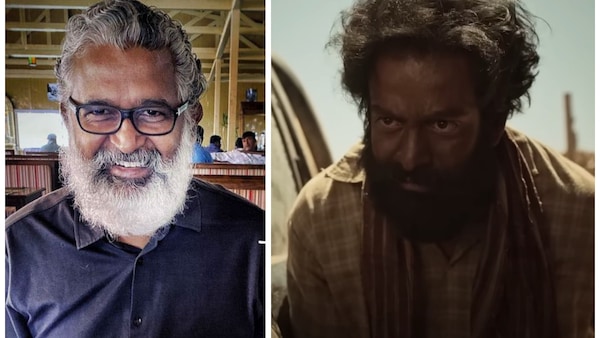Opinion | The effect of faith on Aadujeevitham's box office success
Blessy has achieved this success with Aadujeevitham by sticking to the basic tenets of storytelling. Nothing groundbreaking, just an honest approach to filmmaking.

Blessy and (right) Prithviraj Sukumaran as Najeeb in Aadujeevitham
Last Updated: 05.36 PM, Apr 01, 2024
The success of Aadujeevitham (The Goat Life) is heartwarming. At a time when the old formulas seem to have been rendered redundant in the face of the rapidly evolving cinema landscape worldwide. When the filmmakers in the country pulling out their hair and struggling to figure out what the audience wanted and invent a storytelling templet that would keep the engines of cinema chugging for the next decade, director Blessy flew in with his old-school filmmaking discipline and charmed his way into the hearts of the audiences.
Blessy has achieved this success by sticking to the basic tenets of storytelling. Nothing groundbreaking, just an honest approach to filmmaking and a child-like passion to explore the pleasures of working in a medium like cinema. It's as if he lived in a silo for the last 16 years without letting the world events affect his creativity, faith and discipline in storytelling.
Aadujeevitham, a story of sacrifice, survival, and success
Aadujeevitham follows a very familiar structure in storytelling, with literally no spoilers, which means the possibilities of cliffhangers and edge-of-the-seat moments are very low. Based on a novel first published in 2008, it tells the story of Najeeb Muhammad, who unwittingly becomes a victim of human trafficking and slavery in a foreign country.
Despite audiences knowing the outcome—Najeeb makes it out of the desert hell alive and rejoins his family back in his hometown in Kerala—the film managed to draw viewers to screens in large numbers. It took the biggest-ever opening in the history of Malayalam cinema and is poised for a very long and rewarding run in cinemas worldwide. Additionally, it holds a strong position as a frontrunner for top honours in the next award season.
Aadujeevitham defies all presumptions that the market has about the key to commercial success.
Aadujeevitham begins with an image of the protagonist drinking water from the same bucket as his four-legged companions, goats, do. A highly tanned dark face emerges out of thick hair and beard, under the beautiful night sky in the desert. What a way to establish the protagonist's plight. The first time we see him as a human face among the goats, he has been stripped of his dignity, health, and self-respect.
The narration cycles back to the same moment during the interval. This time, that image hits us harder than it did the first time. Now, we know the name of that face, his beautiful life, his dreams, ambitions, family, and the tragedy that has befallen him. We now identify with the protagonist at a more emotional and personal level. We understand that our goals and desires are not very different from those of Najeeb. And by the roll of the dice, it may very well be us, living the life of a goat under the tyranny of slave masters. And that intimacy hooks us to the protagonist's journey. Even when we know how the story is going to end, we still feel anxious for Najeeb.
Blessy's cinematic masterpiece
We know for a fact that Najeeb survived this ordeal and even managed to tell his tale to the world. Yet, we can't help but get drawn into the moment and share Najeeb's challenges as he navigates through the tricky dunes that keep rolling seemingly with no end in sight. That's the power of cinema and storytelling. A film can have this intended effect on the audience only when the storyteller fully believes in the story. First, the storyteller must put his faith in the story and be convinced about its value in serving the progression of the human race.
One can imagine in the 16-year-long wait to make this film, Blessy may have faced the same struggles as his principal characters, Najeeb, Hakeem, and Ibrahim Khadiri, as they embark on a journey to rejoin civilization, with no resources except for their will to either defeat the deserts or be swallowed by it. There has been more than one time Blessy must have prayed for strength to reimpose his faith in reaching his destination in the face of absolute nothingness, just like the principles.
Aadujeevitham is a product of sheer faith, and that is reflected in each frame, beat of music and sound, and performance. The faith is imprinted in every scene transition done with great artistic sense, every frame showing the starkness of joy and suffering, and cinematographer Sunil K. S's every image capturing the different shades and characters of the desert; in the performances of Prithviraj, Jimmy Jean-Louis, and KR Gokul; in AR Rahman's background score; and in Resul Pookutty's sound design.
It's director Blessy's faith in the story that enabled him to inspire every cast and crew member to craft such a viewing experience. In Aadujeevitham, all elements — image, sound, music, acting, and location — are in perfect sync, striving without ego to serve the main narrative. None dominates the other, creating a truly immersive experience.

